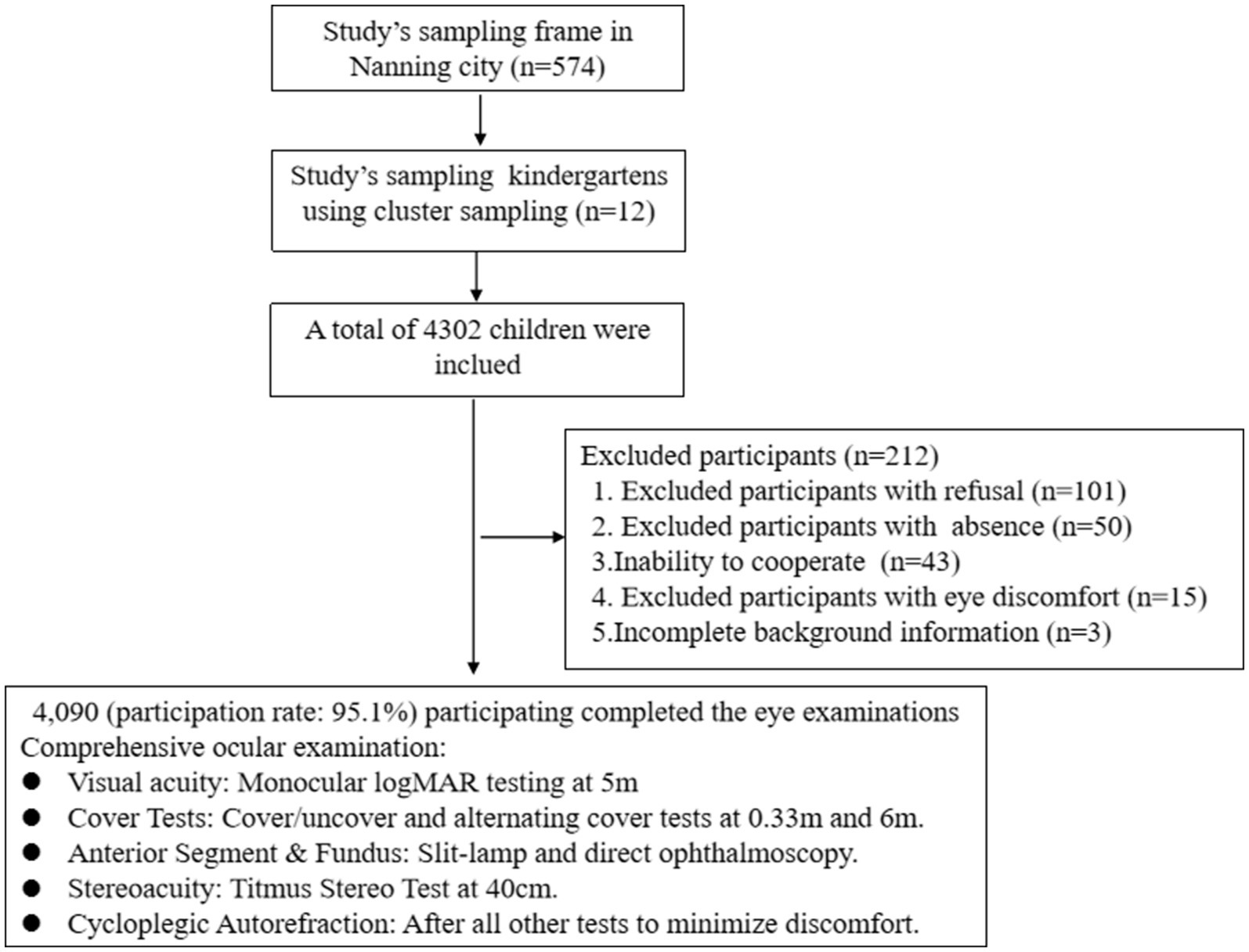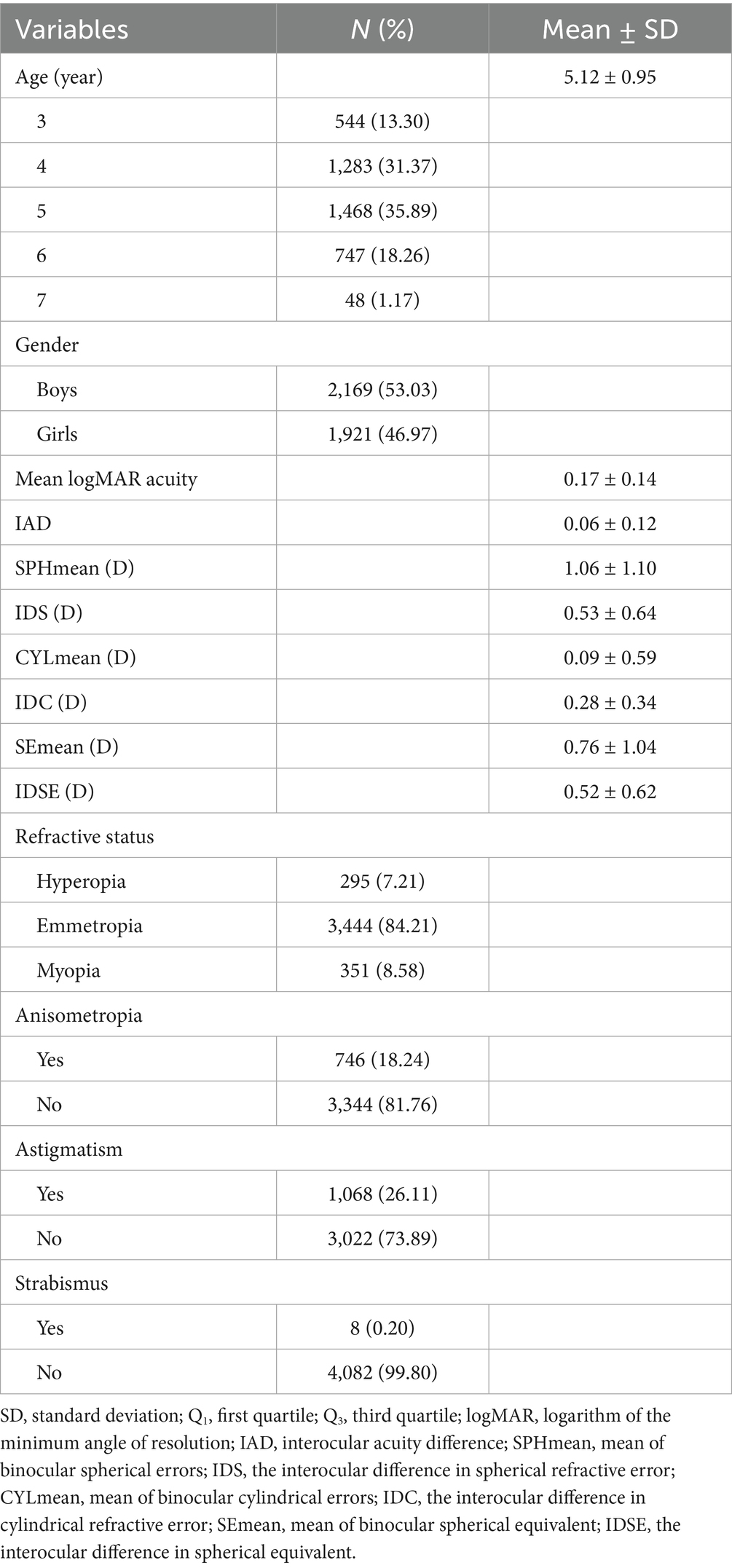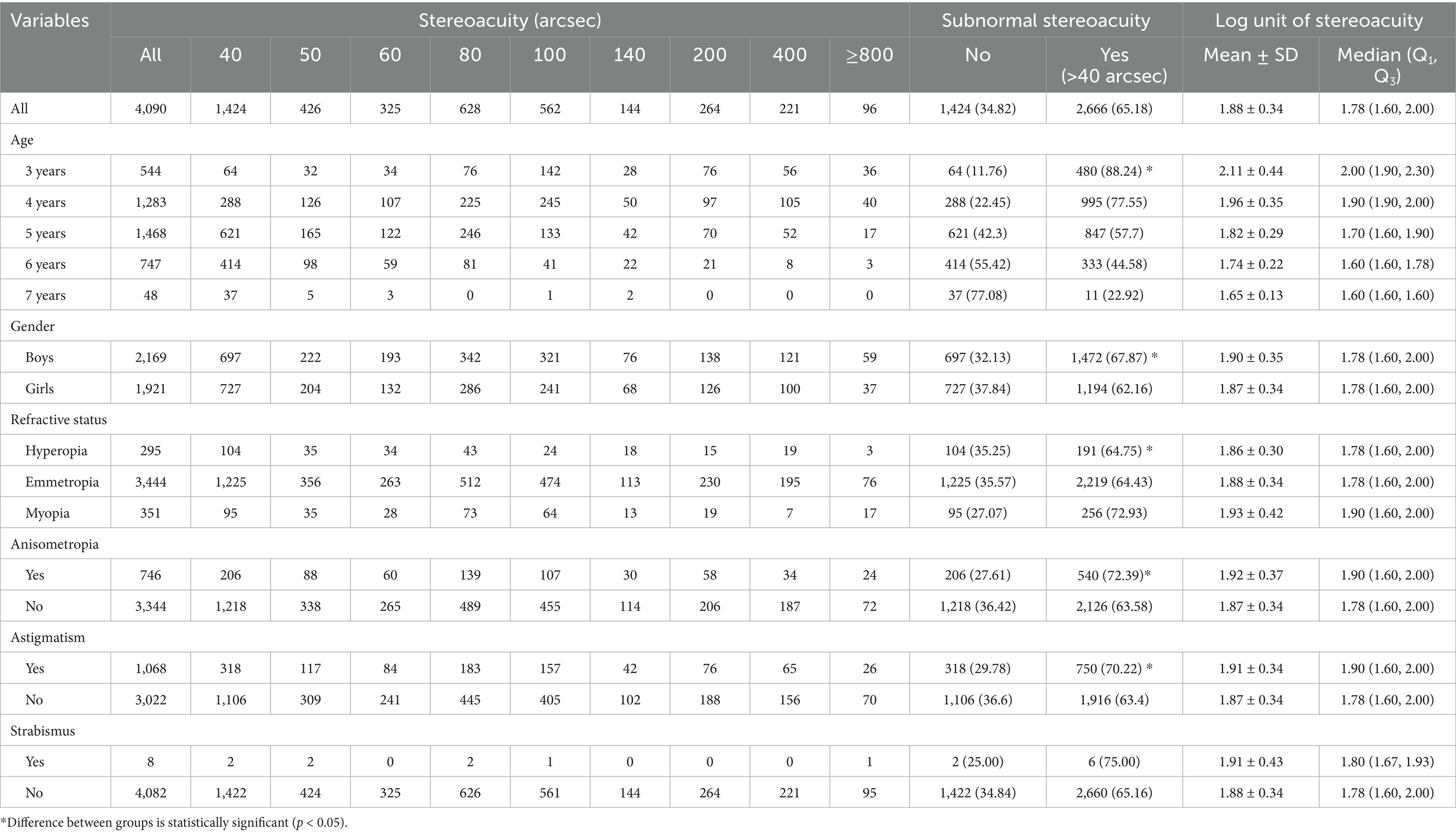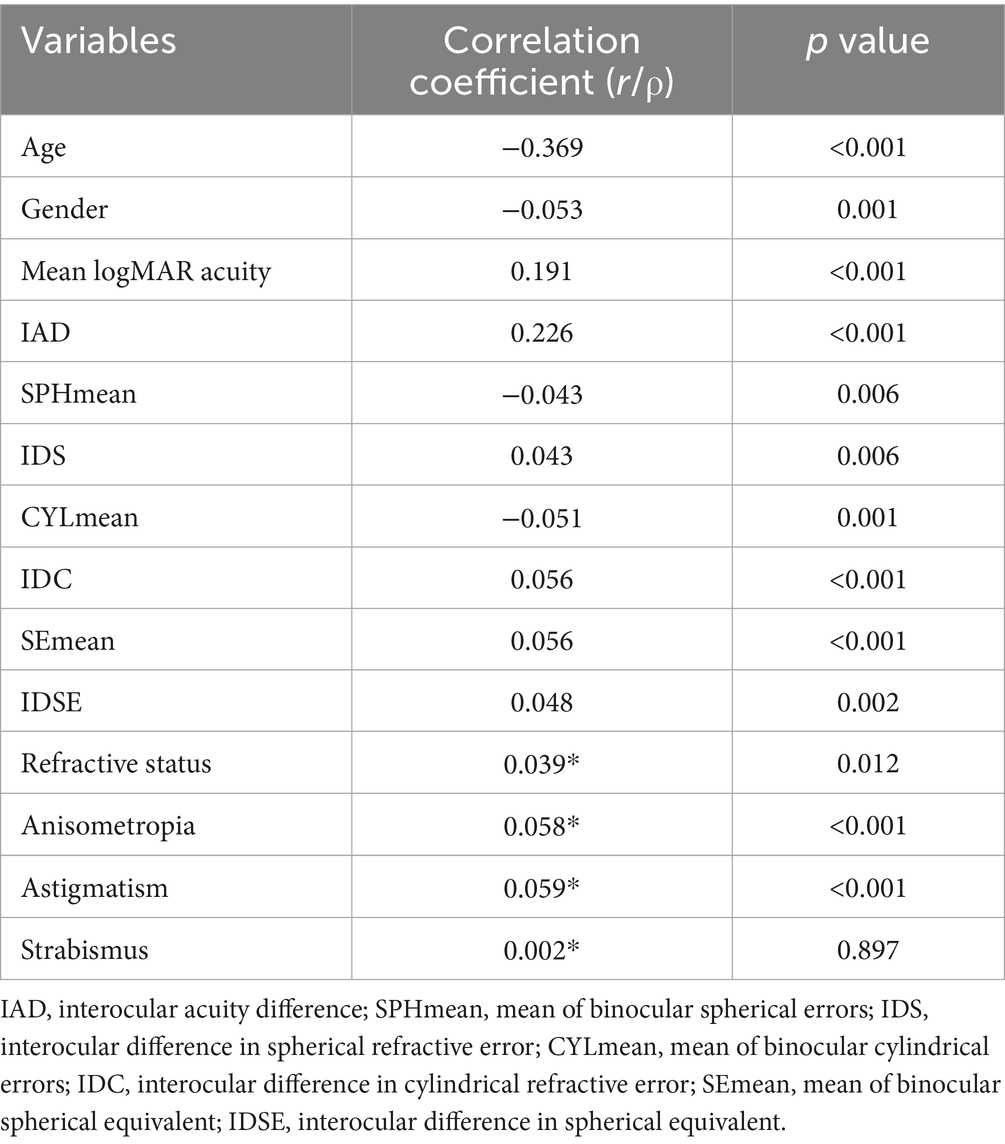- 1Visual Science and Optometry Center of Guangxi, The People’s Hospital of Guangxi Zhuang Autonomous Region, Nanning, China
- 2Guangxi Key Laboratory of Eye Health, The People’s Hospital of Guangxi Zhuang Autonomous Region, Nanning, China
- 3Department of Scientific Research, The People’s Hospital of Guangxi Zhuang Autonomous Region, Nanning, China
Objective: This study aimed to investigate the distribution of stereoacuity and its ocular-associated factors in children aged 3–7 years in Guangxi, Southwest China.
Methods: This cross-sectional study recruited 4,090 children aged 3–7 years (mean: 5.12 ± 0.95 years) from 12 randomly selected kindergartens via cluster sampling in Nanning City, Guangxi, Southwest China. Comprehensive ocular assessments included visual acuity assessment, cover/uncover and alternating cover tests, anterior segment examination, fundus examination, the Titmus stereo test, and cycloplegic autorefraction. The univariate and multivariate logistic regression models were used to determine the factors associated with subnormal stereoacuity (>40 arcsec).
Results: The prevalence rates of anisometropia, astigmatism, and strabismus were 18.24, 26.11, and 0.20%, respectively. The mean stereoacuity was 1.88 ± 0.34 log units (median: 60.25 arcsec), with the majority (65.18%) having subnormal stereoacuity. The mean log units of stereoacuity decreased with age (F = 144.7, p < 0.001). Compared to girls, boys had a significantly greater mean log unit stereoacuity (1.90 ± 0.35 vs. 1.87 ± 0.34, t = 2.589, p = 0.010). In the multivariate logistic regression, older age (odds ratio [OR]: 0.040–0.461 for years 4–7, 95% confidence interval [CI]: 0.018–0.613 for years 4–7, all p < 0.001) and girls (OR = 0.672, 95% CI: 0.584–0.772, p < 0.001) were protective factors, whereas interocular acuity difference [IAD] (OR = 6.906, 95% CI: 3.133–16.01, p < 0.001), mean LogMAR acuity (OR = 11.491, 95% CI: 6.065–22.153, p < 0.001), mean cylindrical error [CYLmean] (OR = 1.201, 95% CI: 1.055–1.365, p = 0.005), and anisometropia (OR = 1.452, 95% CI: 1.202–1.760, p < 0.001) were risk factors for subnormal stereoacuity.
Conclusion: Ocular factors, including higher IAD, worse acuity, greater astigmatism, and greater anisometropia, were identified as risk factors for subnormal stereoacuity, highlighting the importance and urgency of early screening for stereoacuity and ocular risk factors in children aged 3–7 years in Guangxi.
Introduction
Stereoacuity, the ability to perceive depth from differential retinal image positions in both eyes (1), is a fundamental binocular visual function (2, 3). It is critical for various aspects of daily life, including motor skill development (e.g., Purdue pegboard tasks, bead threading, water pouring, and surgical performance) (4) and academic performance (5, 6). It is particularly vital during childhood, as it influences walking (7, 8), quality of life (9, 10), and later-life skills such as driving and professional performance (11, 12). Normal stereoacuity relies on the proper functioning of the ocular, neural, and motor components, making it a valuable indicator of overall visual health (13, 14). In clinical settings, quantifying stereoacuity is crucial for managing strabismus and amblyopia and evaluating treatment outcomes in pediatric trials (15, 16).
Although controversy still exists over the exact age at which stereoscopic vision reaches maturity and stability (17, 18), it is currently widely believed that preschool and elementary school are critical periods for the development and maturity of stereoacuity (19, 20). Early identification of ocular risk factors during these stages is essential for healthcare providers to promote healthy stereoacuity development.
Interocular symmetry is crucial for stereoacuity and binocular vision (21). Previous studies in China have elucidated the stereoscopic development and ocular parameters of school-aged children (16, 19, 20). However, data on the ocular parameters that affect interocular symmetry and their relationships with stereoacuity are limited (21, 22). These parameters, including the interocular difference in spherical equivalent (SE), the interocular difference in cylindrical error, the interocular difference in spherical error, the interocular acuity difference (IAD), and strabismus, have not been extensively investigated, particularly in larger sample sizes or across broader age groups (23). In addition, our previous study revealed that high astigmatism is common among children aged 3–7 years in Guangxi, and magnitude-and orientation-dependent correlations between astigmatism and visual acuity have been confirmed (24). It is worth exploring whether children with ocular-associated factors (such as IAD, strabismus, and high astigmatism) have a greater prevalence of subnormal stereoacuity.
This cross-sectional, school-based study was conducted in Guangxi, Southwest China. It aimed to explore the distribution of stereoacuity and ocular parameters, such as anisometropia, astigmatism, IAD, and strabismus, in children, and to investigate the correlations between stereoacuity and ocular parameters. The research findings provide a basis for considering stereoscopic vision assessment as an indicator in children’s vision screening.
Methods
This cross-sectional study was conducted in Nanning City, Guangxi, Southwest China, from 1 May to 30 October 2020. The sample size was calculated on the basis of a projected 18.5% prevalence of subnormal stereoacuity in 7-year-olds (16), aiming for a 95% confidence level and a 20% error margin. Using the formula (25): n = (Z2 * ρ * (1 − ρ))/B2, where ρ = 0.185, B = 0.185 * 0.20 = 0.037, and Z = 1.96, an initial sample of 2,115 children was required for a uniform age distribution across the 3-to 7-year range. Adjustments for a 20% non-response rate and a 25% increase due to random cluster sampling led to a revised minimum sample size of 3,304 participants.
The study’s sampling frame encompassed 574 kindergartens in Nanning City, of which 12 were randomly selected through school-based cluster sampling. A total of 4,302 children were initially chosen, with 4,090 (participation rate: 95.1%) participating in the eye examinations. A total of 212 participants (4.9%) were excluded, primarily because of refusal (101), absence (50), inability to cooperate (43), eye discomfort (15), or incomplete background information (3). The study flowchart is presented in Figure 1.
Ocular examinations
The children underwent a comprehensive ocular examination, which included visual acuity assessment, cover/uncover and alternating cover tests, anterior segment examination, fundus examination, the Titmus stereo test, and cycloplegic autorefraction (16, 19, 20).
Visual acuity was tested monocularly by nurses (HYH) via an E-letter standard logarithmic visual acuity chart (SJ-LED-01, Guangzhou Shihai Medical Corporation, Guangzhou, China) at 5 m. Visual acuity was expressed in decimal notation and analyzed via the logarithm of the minimum angle of resolution (logMAR) equivalents.
The cover/uncover and alternating cover tests at near (0.33 m) and distances (6 m), administered by experienced pediatric ophthalmologists (QC, YL, WQL, FX, and MK), were used to diagnose children with strabismus.
The anterior segment and ocular media were examined using skilled optometrists (EWL and XX) with a slit lamp microscope, whereas fundus examinations were performed via a direct ophthalmoscope (Beta 200; Heine Optotechnik GmbH & Co., Herrsching, Germany).
Stereoacuity was precisely evaluated using the Titmus stereo test (Stereo Optical Co., Inc., Chicago, IL, United States), following the manufacturer’s instructions (16, 19, 20). The Titmus test includes disparities ranging from 800 to 40 arcsec with unequal step sizes (800, 400, 200, 140, 80, 60, 50, and 40 arcsec). Through a pair of polarizing glasses, subjects viewed the stereogram at a distance of 40 cm and were asked to grasp the wings of the fly. The polarizing glasses were worn over the child’s prescription spectacles, if applicable. If the participant attempted to seize the wings of the fly, they were asked to point to the circle that appeared to “jump” out of the book. If an incorrect response was given, the previous target was reassessed. If an accurate response was repeatedly obtained for the preceding target, the target’s disparity was regarded as the stereoacuity value. The stereoacuity examinations were performed by a small group of trained optometrists (EWL, XX, and LLL) who were instructed to carry out the test under standardized conditions during the daytime. To facilitate clinical interpretation, stereoacuity scores in arcsec were initially transformed to logarithmic values (23).
An autorefractor (KR8900, Topcon, Tokyo, Japan), known for its precision and reliability (26), was used to perform refraction with cycloplegia. Cycloplegia was carried out using three drops of cyclopentolate hydrochloride 1% (Colircusí cycloplegic, Alcon Healthcare S. A., Barcelona) (27). Considering that cycloplegic refraction may cause temporary near vision blurriness and photophobia, autorefraction with cycloplegia was measured in the last step. Three consecutive measurements were taken, with the average value used for analysis.
Definition
The spherical equivalent (SE) was calculated as the sum of the spherical refractive error and half of the cylindrical error (SE = sphere + 0.5 × cylinder), adhering to the International Myopia Institute (IMI) criteria (28). Myopia was classified by SE values of ≤ −0.50 diopters (D), whereas hyperopia was designated for SE values of ≥ +2.00 D. Astigmatism was defined as a cylindrical diopter of ≥ 1.00 D, and anisometropia was defined as a spherical equivalent difference or cylindrical error difference between the two eyes of at least 1.00 D. Mean logMAR acuity represented the average of binocular visual acuity in logMAR units. The interocular acuity difference (IAD) quantified the variation in visual acuity between eyes, expressed in logMAR. IAD was calculated as the absolute difference in best-corrected visual acuity (logMAR) between eyes: IAD = |logMAROD-logMAROS|, where OD = right eye and OS = left eye. Interocular differences in the spherical refractive error (IDS), cylindrical error (IDC), and spherical equivalent (IDSE) were also assessed. SPHmean, CYLmean, and SEmean denote the means of the binocular spherical error, cylindrical error, and spherical equivalent, respectively, with interocular differences reported as absolute values. Strabismus was diagnosed if any tropia, phoria, or microtropia (esotropia, exotropia, or vertical) was observed at either a distance (6 m) or near (0.33 m). Subnormal stereoacuity was operationally defined as a stereoacuity score exceeding 40 arcseconds (16, 19).
Quality control
Stringent quality control procedures were rigorously enforced throughout the study. Each participant received a thorough explanation of the procedures, and informed consent was obtained from participants before the assessments. The fieldwork was supervised by two ophthalmologists (WL and YL) to ensure strict adherence to the established protocols. A random 5% sample of the database was cross-checked for consistency by comparing original documents with electronic records. Data entry was independently performed by two individuals (HH and HL) using EpiData software 3.1 (The EpiData Association, Odense, Denmark), with discrepancies between the databases being resolved through rechecking. Standard operating procedures were developed and implemented for staff training to maintain uniformity and data accuracy.
Statistical analysis
Data analysis was conducted via R programming (version 4.3.2). The normal distribution of the quantitative data was assessed using the Shapiro–Wilk test, and the data are presented as the means ± SDs for normally distributed data or medians (Q1 and Q3) for non-normally distributed data. Qualitative data were expressed as counts and percentages (N [%]). Independent t-tests were used to compare the differences in stereoacuity between the two groups, such as boys and girls. A one-way ANOVA was used to compare the differences in stereoacuity among different age groups. The chi-square test was used to compare the prevalence of subnormal stereoacuity among different groups.
We hypothesized that the log unit of stereoacuity may be associated with age, gender, and ocular measurement of children, with ocular parameters of interocular symmetry, such as, IDSE, IDC, IDS, IAD, and strabismus, and with parameters of refractive error, including SPHmean, CYLmean, SEmean, myopia (SE < −0.50D), hyperopia (SE ≥ +2.00D), anisometropia (IDSE ≥ 1.00D or IDC ≥ 1.00D), and astigmatism (cylindrical diopter≥1.00D).
Pearson’s or Spearman’s correlation analysis was used to assess the relationships between these parameters and log-transformed stereoacuity. To further explore the correlation between ocular parameters and stereoacuity, univariate and multivariate logistic regression models were used to calculate odds ratios (ORs) and their 95% CIs for factors associated with subnormal stereoacuity (>40 arcsec) (16, 19). All statistical tests were two-tailed, and p-values of < 0.05 were considered statistically significant.
Results
Characteristics of the subjects
A total of 4,090 children were enrolled, of which 2,169 (53.03%) were boys. Table 1 displays the characteristics of the subjects; the mean age was 5.12 ± 0.95 years (median: 5.12 years, range: 3.05–7.71 years), and the SE had a mean of 0.76 ± 1.04 diopters (median: 0.88 diopters, range: −10.50 ± 6.13 diopters). The mean cylindrical error was 0.42 ± 0.42 diopters (median: 0.31 diopters, range: 0.00–5.50 diopters), and the mean logMAR acuity was 0.17 ± 0.15 (median: 0.15, range: −0.10 to 2.00).
The prevalence rates of myopia, hyperopia, and emmetropia were 8.58, 7.21, and 84.21%, respectively. The prevalence rates of anisometropia, astigmatism, and strabismus were 18.24, 26.11, and 0.20%, respectively.
Distribution of stereoacuity
Table 2 shows the distribution of stereoacuity stratified by age, gender, and ocular parameters. The mean stereoacuity was 1.88 ± 0.34 log units (median: 60.25 arcsec, range: 40–3,552 arcsec), with the majority (65.18%) of children exhibiting subnormal stereoacuity. Notably, the mean log units of stereoacuity decreased with age (F = 144.7, p < 0.001), and the prevalence of subnormal stereoacuity decreased with increasing age (χ2 = 427.65, p < 0.001). Compared to girls, boys had significantly greater mean log units (1.90 ± 0.35 vs. 1.87 ± 0.34, t = 2.589, p = 0.010). The prevalence rate of subnormal stereoacuity in boys was also greater than that in girls (67.87% vs. 62.16%, χ2 = 14.386, p < 0.001).
There were statistically significant differences in subnormal stereoacuity prevalence among children with hyperopia, emmetropia, and myopia (64.75% vs. 64.43% vs. 72.93%, χ2 = 10.176, p = 0.006). Statistically significant differences were found in the prevalence of subnormal stereoacuity between children with anisometropia and those without anisometropia (72.39% vs. 63.58%, χ2 = 20.471, p < 0.001), as well as between children with astigmatism and those without astigmatism (70.22% vs. 63.40%, χ2 = 15.888, p < 0.001). No statistically significant differences were found in the prevalence of subnormal stereoacuity between children with strabismus and those without strabismus (75.00% vs. 65.16%, χ2 = 0.045, p = 0.832).
Factors associated with stereoacuity via correlation analysis
According to the Pearson’s correlation analysis (Table 3; Figure 2), reduced stereoacuity was statistically correlated with younger age (r = −0.369, p < 0.001), boys (r = −0.053, p = 0.001), higher LogMAR acuity (worse visual acuity, r = 0.196, p < 0.001), increased IAD (r = 0.156, p < 0.001), IDS (r = 0.043, p = 0.006), IDC (r = 0.056, p < 0.001), IDSE (r = 0.048, p = 0.002), SEmean (r = 0.056, p < 0.001), decreased SPHmean (r = −0.043, p = 0.006), and decreased CYLmean (r = −0.051, p = 0.001). Spearman’s correlation analysis revealed that there was a significant correlation between reduced stereoacuity and refractive status (ρ = 0.039, p = 0.012), anisometropia (ρ = 0.058, p < 0.001), and astigmatism (ρ = 0.059, p < 0.001), whereas there was no significant association between stereoacuity and strabismus (ρ = 0.002, p = 0.897).
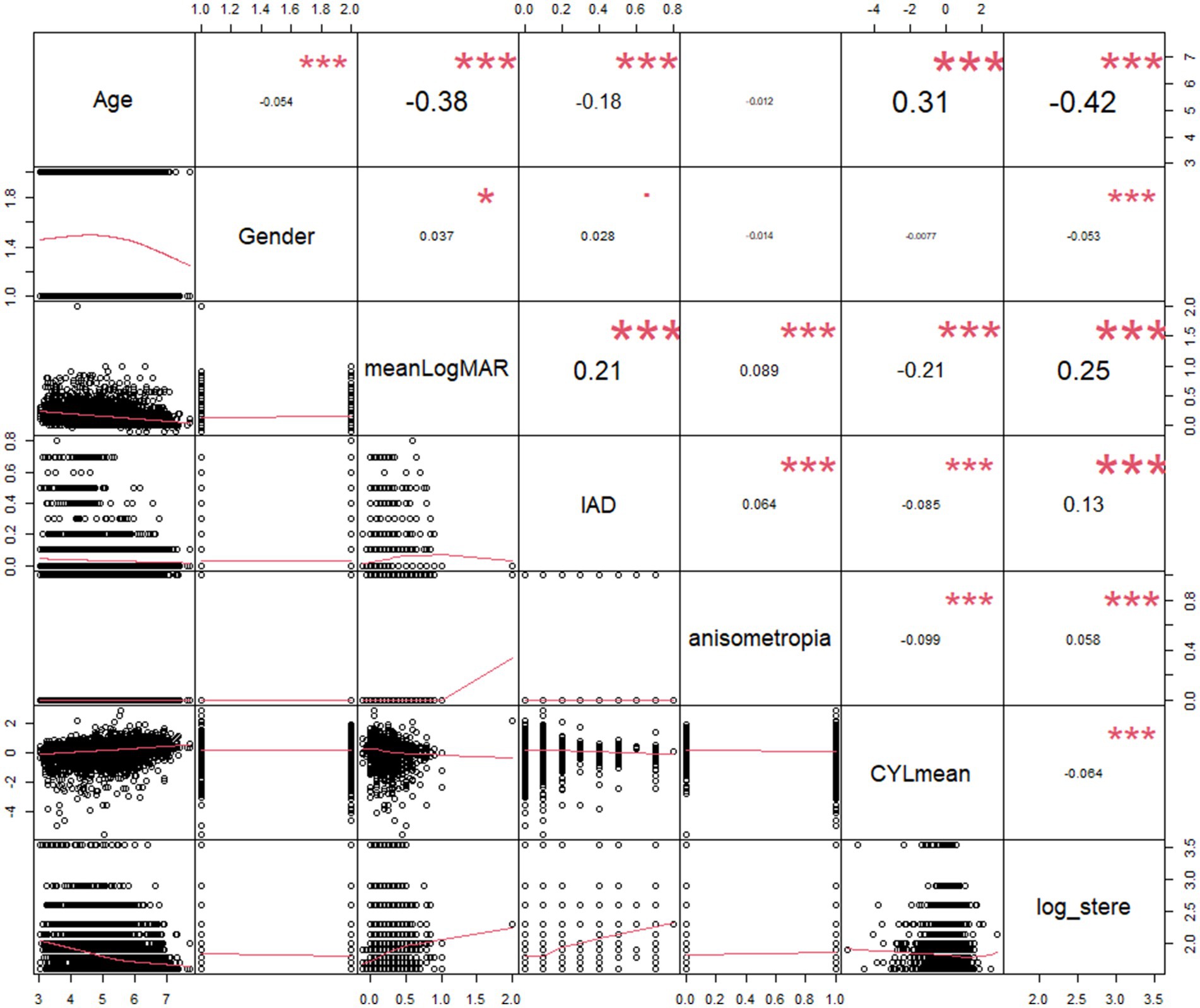
Figure 2. Scatterplot of the log value of stereoacuity with its correlates. IAD, interocular acuity difference; meanLogMAR, mean of binocular LogMAR; CYLmean, mean of binocular cylindrical errors; log_stere, log unit of stereoacuity.
Factors associated with subnormal stereoacuity via logistic regression
In the logistic regression analysis, we incorporated age, gender, mean LogMAR acuity, IAD, IDS, IDC, IDSE, SPHmean, SEmean, CYLmean, refractive status, anisometropia, astigmatism, and strabismus as predictors of subnormal stereoacuity, and almost all the predictors, with the exception of strabismus, were statistically significantly associated with subnormal stereoacuity in the univariate model (all p < 0.05, Table 4). We further developed a multivariate logistic regression model with these significant predictors of univariate analysis and used a stepwise approach based on the Akaike information criterion (AIC) for selecting variables. We identified the final model with an AIC of 4711.5 and revealed that older age (OR: 0.040 ~ 0.461 for years 4–7, 95% CI: 0.018–0.613 for years 4–7, all p < 0.001) and girls (OR = 0.672, 95% CI: 0.584–0.772, p < 0.001) were protective factors against subnormal stereoacuity, whereas IAD (OR = 6.906, 95% CI: 3.133–16.01, p < 0.001), mean LogMAR acuity (OR = 11.491, 95% CI: 6.065–22.153, p < 0.001), CYLmean (OR = 1.201, 95% CI: 1.055–1.365, p = 0.005), and anisometropia (OR = 1.452, 95% CI: 1.202–1.760, p < 0.001) were positively associated with an increased likelihood of subnormal stereoacuity (Table 4).
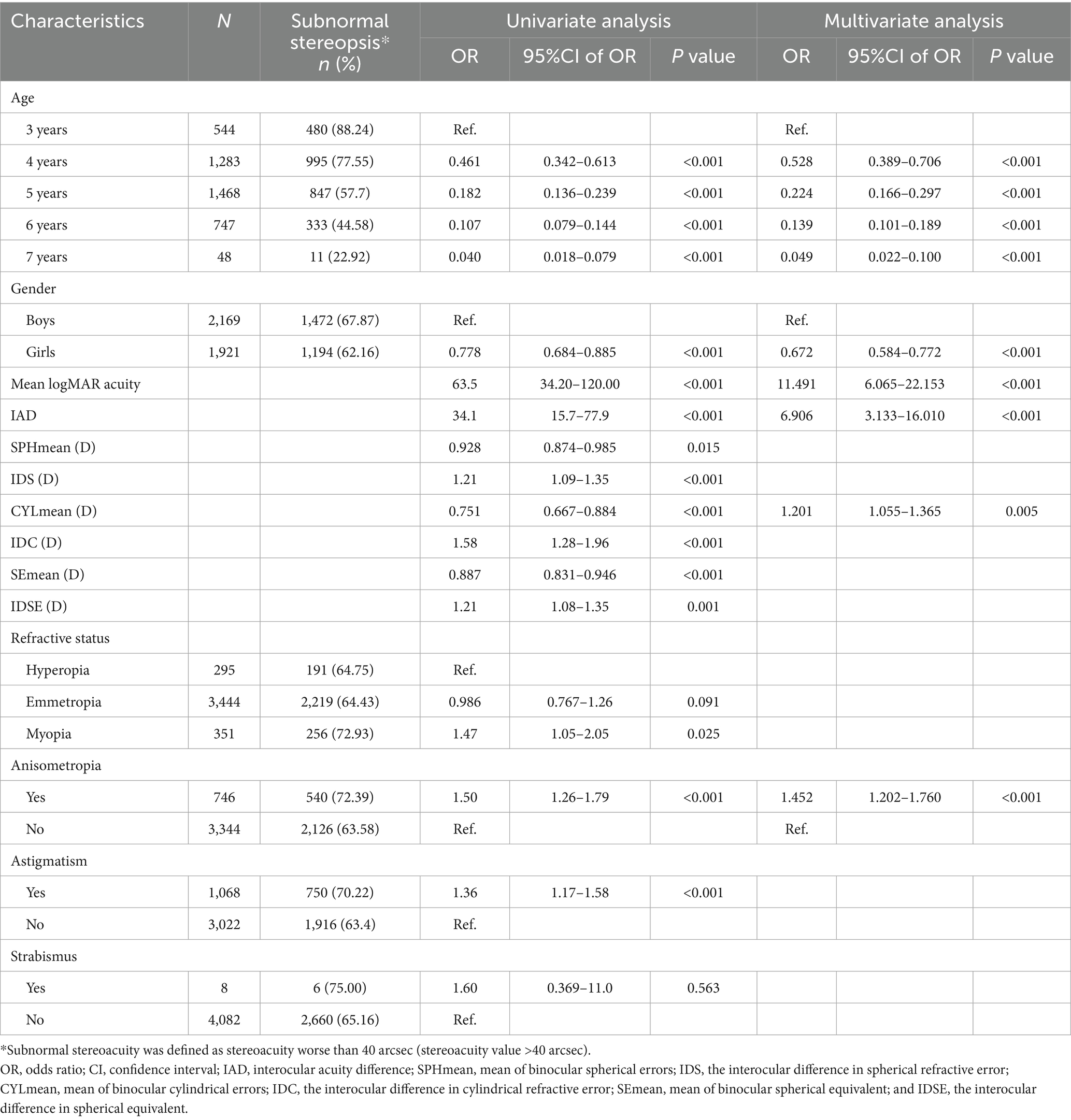
Table 4. Univariate and multivariate logistic regression analyses for associations between ocular parameters and stereoacuity (log unit).
Discussion
This large-scale, school-based cross-sectional investigation examined stereoacuity and its ocular correlates in children aged 3–7 years in Nanning City, Guangxi, Southwest China, a region with diverse ethnic minorities (29). The mean stereoacuity was 1.88 ± 0.34 log units (median: 60.25 arcsec), with 65.18% having subnormal (>40 arcsec) stereoacuity. The prevalence rates of anisometropia, astigmatism, and strabismus were 18.24, 26.11, and 0.20%, respectively. After adjusting for covariates, IAD (OR = 6.906, p < 0.001), mean LogMAR acuity (OR = 11.491, p < 0.001), CYLmean (OR = 1.201, p = 0.005), and anisometropia (OR = 1.452, p < 0.001) were risk factors for subnormal stereoacuity. Our findings contribute new insights into the distribution of stereoacuity and its associations with ocular parameters in children through the Titmus stereo test.
The test was completed by 95.1% of participants. The mean log unit of stereoacuity decreased with age (2.11 ± 0.44 log arcsec for 3-year-olds, decreasing to 1.65 ± 0.13 log arcsec for 7-year-olds, F = 144.7, p < 0.001), suggesting improved stereoacuity scores as children aged (1, 6), which is consistent with prior research (13, 19, 20). However, controversy still remains regarding the exact age at which stereoscopic vision reaches maturity and stability. Oduntan et al.’s study using the Randot Stereo test suggested a later maturation period for boys aged 6–12 years (30). Birch et al.’s research with the Randot Preschool Stereoacuity Test showed ongoing improvement until 10 years (15, 31). There is a contradiction between different studies on the precise age of stable and mature stereoacuity development, which may be explained by ethnic differences in study subjects (15, 21, 22, 31, 32) and differences in stereoscopic assessment methods (e.g., the Titmus, Randot, or Lang stereo test tools) (22, 32, 33). Our study’s correlation analysis and multivariate analysis results supported that age was correlated with stereoacuity, which emphasizes the importance of stereoacuity screening for children aged 3–7 years (20, 34). Further research is needed to clarify the health economic benefits of stereoacuity screening in this age group.
Our study revealed statistically significant gender differences, with boys exhibiting greater mean log units of stereoacuity than girls did (1.90 ± 0.35 vs. 1.87 ± 0.34 log arcsec, t = 2.589, p = 0.010). Gender was a significant predictor in the multivariate model, negatively correlated with stereoacuity (r = −0.053, p = 0.001), and associated with increased odds of subnormal stereoacuity in boys (OR = 0.672, 95% CI: 0.584–0.772, p < 0.001). This finding aligns with Potluri et al.’s research using the Titmus stereoacuity test in a sample of 2,376 children aged 7–14 years and reported slightly better stereoacuity in girls (31). In contrast, in their study of 942 children aged 4–5 years, Han et al., who used the same test, did not detect a significant gender association (19). Our results suggest that girls’ faster visual development during early childhood, as suggested by previous research (35), may contribute to this gender disparity.
Our findings are consistent with those of previous studies that have reported an association between lower visual acuity and weaker stereoacuity in different age groups (19, 20, 32, 36). Schmid et al. (36) and Sandfeld et al. (32) reported a connection between poor stereoscopic performance and reduced visual acuity in children, supporting our observations. A study of preschool children (19) revealed a correlation between improved visual acuity and higher stereoacuity scores. Furthermore, a study by Guo et al. (20) revealed a statistically significant association between a greater intereye difference in best-corrected visual acuity (logMAR) and reduced stereoacuity in a cohort aged 4–18 years, thereby corroborating our results.
This study revealed a high prevalence of astigmatism in children in Guangxi (26.11%), which confirmed our previous findings (24). Our multivariate logistic regression analysis revealed that, after adjusting for the mean logMAR acuity and IAD, an increase in the binocular cylinder error (CYLmean) was a significant risk factor for subnormal stereoacuity (OR = 1.201, 95% CI: 1.055–1.365, p = 0.005), indicating that astigmatism is an independent risk factor for stereoacuity, which is consistent with the findings of previous studies (23, 26, 37, 38). The association of astigmatism is believed to be due to factors such as optical blur, foveal suppression, or selective changes in the nerves within the VI cortex (39).
In addition, anisometropia was significantly correlated with stereoacuity (r = 0.058, p < 0.001), and the risk of subnormal stereoacuity among children with anisometropia was 1.452 times greater than that among those without anisometropia (OR = 1.452, 95% CI: 1.202–1.760, p < 0.001), highlighting the substantial effect of interocular refractive asymmetry on stereoacuity. The studies by Ying et al. (38) reported that a greater degree of anisometropia was associated with worse stereoacuity in a dose–response manner in children, supporting our observations. The mechanism by which anisometropia impairs children’s stereoacuity is primarily through interrupting normal binocular fusion (26, 40, 41).
Similarly, numerous studies have revealed that strabismus is another key factor affecting the development of stereoacuity, mainly by affecting interocular optical asymmetry to harm stereoacuity (23, 32, 42–44). However, our study used Spearman’s rank analysis and did not find a significant association between strabismus and subnormal stereoacuity. This deviation from the established association may be attributed to the extremely low prevalence of strabismus (0.20%, with only eight children suffering from strabismus) in Nanning children. Our strabismus prevalence (0.20%) may underrepresent intermittent exotropia due to single-time point screening. Future studies should incorporate repeated cover tests or home-based assessments to capture transient deviations.
The robustness of our study is substantiated by its large sample size, high response rate, inclusion of age-specific participants, comprehensive assessments, and adherence to standardized procedures supervised by ophthalmologists, optometrists, and medical professionals. Despite these strengths, several limitations should be acknowledged. First, the reliance of the Titmus stereo test on monocular cues might enable several children to provide correct responses through these cues (45). In addition, the clinical value of stereoacuity screening lies in the fact that it may indicate potential visual system issues, including refractive errors, strabismus, and anisometropia. Stereoacuity testing can reveal subtle deficits in depth perception that might not otherwise be detected. In some cases, even a mild impairment of stereoacuity may indicate an increased risk of other visual or developmental problems later in life. For example, children with poor stereoacuity may be more likely to experience academic or developmental delays due to difficulties with spatial awareness and hand–eye coordination (46).
However, a previous study indicated that the influence of monocular cues on stereoacuity is minimal and thus unlikely to significantly affect the multivariate regression results (26). The accuracy of stereoacuity measurements via the Titmus test depends on children’s focus and cognitive abilities (1), which, given their developing nature at preschool age (47, 48), may impact the observed correlations between stereoacuity and accuracy. Second, as our study is cross-sectional, future research with a longitudinal cohort design and a substantial sample size will be necessary to further validate our findings and enhance their generalizability. Third, the 12 kindergartens in this study were all located in the urban area of Nanning, and the sample lacked socioeconomic composition (no questionnaire survey), which limits the external applicability of the research results.
In conclusion, our study demonstrated that the mean stereoacuity was 1.88 ± 0.34 log units (median: 60.25 arcsec), with 65.18% of children exhibiting subnormal stereoacuity (>40 arcsec). The prevalence rates of anisometropia, astigmatism, and strabismus were 18.24, 26.11, and 0.20%, respectively. A significant correlation was observed between reduced stereoacuity and ocular factors, including age, gender, mean LogMAR acuity, IAD, IDS, IDC, IDSE, SPHmean, SEmean, CYLmean, refractive status, anisometropia, and astigmatism, as predictors of subnormal stereoacuity, with the exception of strabismus. Age and gender were identified as protective factors, while increased interocular acuity difference (IAD), mean logMAR acuity, mean binocular cylindrical error (CYLmean), and anisometropia were risk factors for subnormal stereoacuity after adjusting for covariates. Therefore, these factors should be recognized as important predictors of subnormal stereopsis. The clinical value of stereoacuity screening lies in its potential to suggest certain underlying visual system disorders in school screening, especially in cases where an ophthalmologist is not available. To reinforce these findings, future research should focus on longitudinal, multicenter studies with large sample sizes to enhance generalizability.
Data availability statement
The raw data supporting the conclusions of this article will be made available by the authors, without undue reservation.
Ethics statement
The studies involving humans were approved by the ethics committee of People’s Hospital of Guangxi Zhuang Autonomous Region. The studies were conducted in accordance with the local legislation and institutional requirements. Written informed consent for participation was not required from the participants or the participants’ legal guardians/next of kin in accordance with the national legislation and institutional requirements. Written informed consent was obtained from the individual(s) for the publication of any potentially identifiable images or data included in this article.
Author contributions
XX: Conceptualization, Formal analysis, Writing – original draft, Writing – review & editing. HH: Investigation, Writing – original draft, Writing – review & editing. YL: Data curation, Investigation, Writing – original draft. WL: Investigation, Project administration, Writing – original draft. LL: Investigation, Writing – original draft. EL: Data curation, Investigation, Writing – review & editing. MK: Data curation, Investigation, Writing – review & editing. QC: Conceptualization, Supervision, Writing – review & editing.
Funding
The author(s) declare that financial support was received for the research and/or publication of this article. The authors acknowledge support from the Guangxi Key Research and Development Plan Project (No. Guike AB23026047), Guangxi Clinical Ophthalmic Research Center (No. Guike AD19245193), Guangxi Medical and Health Appropriate Technology Research and Development Project (S201550), and Guangdong Basic and Applied Basic Research Foundation (No. 2021A1515011822).
Conflict of interest
The authors declare that the research was conducted in the absence of any commercial or financial relationships that could be construed as a potential conflict of interest.
Generative AI statement
The authors declare that no Gen AI was used in the creation of this manuscript.
Publisher’s note
All claims expressed in this article are solely those of the authors and do not necessarily represent those of their affiliated organizations, or those of the publisher, the editors and the reviewers. Any product that may be evaluated in this article, or claim that may be made by its manufacturer, is not guaranteed or endorsed by the publisher.
References
1. Romano, PE, Romano, JA, and Puklin, JE. Stereoacuity development in children with normal binocular single vision. Am J Ophthalmol. (1975) 79:966–71. doi: 10.1016/0002-9394(75)90679-0
2. Klimmasch, L, Schneider, J, Lelais, A, Fronius, M, Shi, BE, and Triesch, J. The development of active binocular vision under Normal and alternate rearing conditions. eLife. (2021) 10:10. doi: 10.7554/eLife.56212
3. O'Connor, AR, Birch, EE, Anderson, S, and Draper, H. The functional significance of stereopsis. Invest Ophthalmol Vis Sci. (2010) 51:2019–23. doi: 10.1167/iovs.09-4434
4. Al-Saud, LM, Mushtaq, F, Mirghani, I, Balkhoyor, A, Keeling, A, Manogue, M, et al. Drilling into the functional significance of stereopsis: the impact of stereoscopic information on surgical performance. Ophthalmic Physiol Opt. (2017) 37:498–506. doi: 10.1111/opo.12393
5. Hopkins, S, Black, AA, White, SLJ, and Wood, JM. Visual information processing skills are associated with academic performance in grade 2 school children. Acta Ophthalmol. (2019) 97:e1141–8. doi: 10.1111/aos.14172
6. Ponsonby, AL, Smith, K, Williamson, E, Bridge, D, Carmichael, A, Dwyer, T, et al. Poor Stereoacuity among children with poor literacy: prevalence and associated factors. Optometry Vis Sci. (2013) 90:75–83. doi: 10.1097/OPX.0b013e3182780dd0
7. Zhao, J, and Allison, RS. The role of binocular vision in avoiding virtual obstacles while walking. IEEE Trans Vis Comput Graph. (2021) 27:3277–88. doi: 10.1109/tvcg.2020.2969181
8. Hayhoe, M, Gillam, B, Chajka, K, and Vecellio, E. The role of binocular vision in walking. Vis Neurosci. (2009) 26:73–80. doi: 10.1017/s0952523808080838
9. Rahi, JS, Cumberland, PM, and Peckham, CS. Visual impairment and vision-related quality of life in working-age adults: findings in the 1958 British birth cohort. Ophthalmology. (2009) 116:270–4. doi: 10.1016/j.ophtha.2008.09.018
10. Cumberland, PM, and Rahi, JS. Visual function, social position, and health and life chances: the Uk biobank study. JAMA Ophthalmol. (2016) 134:959–66. doi: 10.1001/jamaophthalmol.2016.1778
11. Zhu, XJ, Li, YH, and Liu, LQ. Functional significance of stereopsis in professional table-tennis players. J Sports Med Phys Fitness. (2019) 59:1798–804. doi: 10.23736/s0022-4707.19.09300-9
12. Dakroub, M, Boueiri, M, and Al-Haddad, C. A review of driving and binocularity. J Pediatr Ophthalmol Strabismus. (2022) 59:6–12. doi: 10.3928/01913913-20210518-02
13. Surasmiati, NMA, Wetarini, K, Wijayati, MP, and Suryathi, NMA. Stereoacuity test as a screening tool for amblyopia and binocular vision in children 6-12 years of age. Universa Medicina. (2024) 43:280–6. doi: 10.18051/UnivMed.2024.v43.280-286
14. Fricke, TR, and Siderov, J. Stereopsis, Stereotests, and their relation to vision screening and clinical practice. Clin Exp Optom. (1997) 80:165–72. doi: 10.1111/j.1444-0938.1997.tb04876.x
15. Birch, E, Williams, C, Drover, J, Fu, V, Cheng, C, Northstone, K, et al. Randot preschool Stereoacuity test: normative data and validity. J AAPOS. (2008) 12:23–6. doi: 10.1016/j.jaapos.2007.06.003
16. Sun, Y, Fu, J, Li, L, Chen, W, Meng, Z, Su, H, et al. Stereoacuity and its determinants in 7-year-old children: the Lhasa childhood eye study. Graefes Arch Clin Exp Ophthalmol. (2022) 260:599–608. doi: 10.1007/s00417-021-05390-y
17. Hong, SW, and Park, SC. Development of distant Stereoacuity in visually Normal children as measured by the Frisby-Davis distance Stereotest. Br J Ophthalmol. (2008) 92:1186–9. doi: 10.1136/bjo.2008.138362
18. Castro, JJ, Jiménez, JR, Ortiz, C, Casares-López, M, and Ortiz-Peregrina, S. The range of stereoscopic perception: influence of binocular summation, Interocular differences in optical quality and halo perception. J Mod Opt. (2017) 64:1307–14. doi: 10.1080/09500340.2017.1286397
19. Han, S, Zhang, X, Zhao, X, Wang, Y, Hao, Q, Li, R, et al. Stereoacuity and related factors in healthy preschool children: the Nanjing eye study. Ophthalmic Epidemiol. (2019) 26:336–44. doi: 10.1080/09286586.2019.1624782
20. Guo, DD, Wu, JF, Hu, YY, Sun, W, Lv, TL, Jiang, WJ, et al. Stereoacuity and related factors: the Shandong children eye study. PLoS ONE. (2016) 11:e0157829. doi: 10.1371/journal.pone.0157829
21. Arba Mosquera, S, and Verma, S. Bilateral symmetry in vision and influence of ocular surgical procedures on binocular vision: a topical review. J Optom. (2016) 9:219–30. doi: 10.1016/j.optom.2016.01.005
22. Bankó, ÉM, Barboni, MTS, Markó, K, Körtvélyes, J, Németh, J, Nagy, ZZ, et al. Fixation instability, astigmatism, and lack of stereopsis as factors impeding recovery of binocular balance in amblyopia following binocular therapy. Sci Rep. (2022) 12:10311. doi: 10.1038/s41598-022-13947-y
23. Robaei, D, Huynh, SC, Kifley, A, Gole, GA, and Mitchell, P. Stereoacuity and ocular associations at age 12 years: findings from a population-based study. J Am Assoc Pediatr Ophthalmol Strabismus. (2007) 11:356–61. doi: 10.1016/j.jaapos.2006.11.111
24. Xiao, X, Liu, WM, Ye, YJ, Huang, JZ, Luo, WQ, Liu, HT, et al. Prevalence of high astigmatism in children aged 3 to 6 years in Guangxi, China. Optom Vis Sci. (2014) 91:390–6. doi: 10.1097/opx.0000000000000221
25. Negrel, AD, Maul, E, Pokharel, GP, Zhao, J, and Ellwein, LB. Refractive error study in children: sampling and measurement methods for a multi-country survey. Am J Ophthalmol. (2000) 129:421–6. doi: 10.1016/s0002-9394(99)00455-9
26. Yang, JW, Huang, TY, Lee, JS, Yeung, L, Lin, YF, and Sun, CC. Correlation between myopic Ametropia and Stereoacuity in school-aged children in Taiwan. Jpn J Ophthalmol. (2013) 57:316–9. doi: 10.1007/s10384-013-0231-2
27. Xiong, S, Lv, M, Zou, H, Zhu, J, Lu, L, Zhang, B, et al. Comparison of refractive measures of three autorefractors in children and adolescents. Optom Vis Sci. (2017) 94:894–902. doi: 10.1097/opx.0000000000001113
28. Flitcroft, DI, He, M, Jonas, JB, Jong, M, Naidoo, K, Ohno-Matsui, K, et al. Imi-defining and classifying myopia: a proposed set of standards for clinical and epidemiologic studies. Invest Ophthalmol Vis Sci. (2019) 60:M20–m30. doi: 10.1167/iovs.18-25957
29. Mo, L, Zeng, Z, Li, Y, Li, D, Yan, CY, Xiao, S, et al. Animal study of the anti-diarrhea effect and microbial diversity of dark tea produced by the Yao population of Guangxi. Food Funct. (2019) 10:1999–2009. doi: 10.1039/c9fo00110g
30. Oduntan, AO, Al-Ghamdi, M, and Al-Dosari, H. Randot Stereoacuity norms in a population of Saudi Arabian children. Clin Exp Optom. (1998) 81:193–7. doi: 10.1111/j.1444-0938.1998.tb06734.x
31. Potluri, RK, Akella, SV, Mallidi, R, Uppala, NR, and Jujjavarapu, RP. Study on Stereoacuity and associated factors in school children aged 7 to 14 years. Indian J Ophthalmol. (2022) 70:233–7. doi: 10.4103/ijo.IJO_1572_21
32. Sandfeld, L, Weihrauch, H, Tubaek, G, and Mortzos, P. Ophthalmological data on 4.5- to 7-year-old Danish children. Acta Ophthalmol. (2018) 96:379–83. doi: 10.1111/aos.13650
33. Elamurugan, V, Shankaralingappa, P, Aarthy, G, Kasturi, N, and Babu, RK. Assessment of stereopsis in pediatric and adolescent spectacle-corrected refractive error - a cross-sectional study. Indian J Ophthalmol. (2022) 70:604–8. doi: 10.4103/ijo.IJO_997_21
34. Fox, R, Patterson, R, and Francis, EL. Stereoacuity in young children. Invest Ophthalmol Vis Sci. (1986) 27:598–600.
35. Li, J. Gender never defines me: a study on preschool teachers' do and Don't about gender. Soc Sci Humanit Open. (2023) 7:100397. doi: 10.1016/j.ssaho.2023.100397
36. Schmid, M, and Largo, RH. Visual acuity and stereopsis between the ages of 5 and 10 years. A cross-sectional study. Eur J Pediatr. (1986) 145:475–9. doi: 10.1007/bf02429046
37. Dobson, V, Miller, JM, Clifford-Donaldson, CE, and Harvey, EM. Associations between Anisometropia, amblyopia, and reduced Stereoacuity in a school-aged population with a high prevalence of astigmatism. Invest Ophthalmol Vis Sci. (2008) 49:4427–36. doi: 10.1167/iovs.08-1985
38. Ying, G-s, Huang, J, Maguire, MG, Quinn, G, Kulp, MT, Ciner, E, et al. Associations of Anisometropia with unilateral amblyopia, Interocular acuity difference, and Stereoacuity in preschoolers. Ophthalmology. (2013) 120:495–503. doi: 10.1016/j.ophtha.2012.08.014
39. Cumming, BG, and DeAngelis, GC. The physiology of stereopsis. Annu Rev Neurosci. (2001) 24:203–38. doi: 10.1146/annurev.neuro.24.1.203
40. Tomaç, S, and Birdal, E. Effects of Anisometropia on binocularity. J Pediatr Ophthalmol Strabismus. (2001) 38:27–33. doi: 10.3928/0191-3913-20010101-09
41. Jeon, HS, and Choi, DG. Stereopsis and fusion in Anisometropia according to the presence of amblyopia. Graefes Arch Clin Exp Ophthalmol. (2017) 255:2487–92. doi: 10.1007/s00417-017-3798-3
42. Williams, S, Simpson, A, and Silva, PA. Stereoacuity levels and vision problems in children from 7 to 11 years. Ophthalmic Physiol Opt. (1988) 8:386–9. doi: 10.1111/j.1475-1313.1988.tb01173.x
43. Afsari, S, Rose, KA, Pai, AS, Gole, GA, Leone, JF, Burlutsky, G, et al. Diagnostic reliability and normative values of Stereoacuity tests in preschool-aged children. Br J Ophthalmol. (2013) 97:308–13. doi: 10.1136/bjophthalmol-2012-302192
44. Adams, WE, Hrisos, S, Richardson, S, Davis, H, Frisby, JP, and Clarke, MP. Frisby Davis distance Stereoacuity values in visually Normal children. Br J Ophthalmol. (2005) 89:1438–41. doi: 10.1136/bjo.2005.071761
45. Leske, DA, and Holmes, JM. Maximum angle of horizontal strabismus consistent with true stereopsis. J AAPOS. (2004) 8:28–34. doi: 10.1016/j.jaapos.2003.08.010
46. Xiao, X, Yang, X, Luo, Y, Li, L, Lin, E, Kong, M, et al. Increasing myopic refraction reduces random dot stereopsis in Chinese myopic patients: a cross-sectional study. BMC Ophthalmol. (2025) 25:260. doi: 10.1186/s12886-025-04098-5
47. Passolunghi, MC, and Lanfranchi, S. Domain-specific and domain-general precursors of mathematical achievement: a longitudinal study from kindergarten to first grade. Br J Educ Psychol. (2012) 82:42–63. doi: 10.1111/j.2044-8279.2011.02039.x
Keywords: children, stereoacuity, visual acuity, anisometropia, astigmatism
Citation: Xiao X, Huang H, Luo Y, Luo W, Li L, Lin E, Kong M and Chen Q (2025) Stereoacuity and ocular-associated factors in children aged 3–7 years in Guangxi, Southwest China: a cross-sectional study. Front. Med. 12:1562041. doi: 10.3389/fmed.2025.1562041
Edited by:
Yi Du, The First Affiliated Hospital of Guangxi Medical University, ChinaReviewed by:
Jie Cai, Guangxi Medical University, ChinaJialin Zhan, Shanghai University of Medicine and Health Sciences, China
Copyright © 2025 Xiao, Huang, Luo, Luo, Li, Lin, Kong and Chen. This is an open-access article distributed under the terms of the Creative Commons Attribution License (CC BY). The use, distribution or reproduction in other forums is permitted, provided the original author(s) and the copyright owner(s) are credited and that the original publication in this journal is cited, in accordance with accepted academic practice. No use, distribution or reproduction is permitted which does not comply with these terms.
*Correspondence: Qi Chen, MjI4Njk5MjIzQHFxLmNvbQ==
†These authors have contributed equally to this work and share first authorship
 Xin Xiao
Xin Xiao Huiyao Huang1†
Huiyao Huang1† Wuqiang Luo
Wuqiang Luo Lili Li
Lili Li Enwei Lin
Enwei Lin Qi Chen
Qi Chen